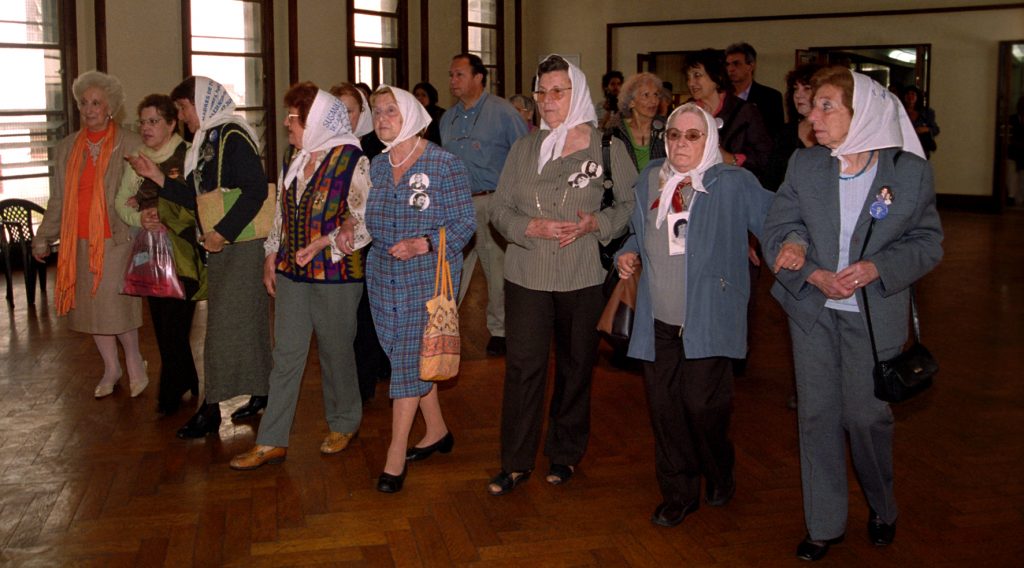Grandmothers and Mothers of Plaza de Mayo

Mothers of the Plaza de Mayo. Photo by: Mónica Hasenberg
Isabel Peron was an odd character: the third wife of Peron, the first female president of Argentina, her chief advisor a big believer in occult matters and fortune telling, and there are several reports of her using astrological divination to determine national policy during her presidency. By all accounts she was a little crazy and almost completely inexperience when she took over the government after Peron’s death.
“Already with a party that had a huge gap between the young and the old. The young had already taken guns. They wanted to do a revolution like in Cuba. In this case the vice president was Isabel Peron. So, Isabel Peron took power she was a dancer they met in exile she didn’t know anything.”
So, when she took over, she trusted a little too much in the ministers to just ‘do their jobs’.
“There was a big economic crisis too. In ’74 when Peron died, Isabel lets a minister, organize a secret police called Triple A, Alianza Anticomunista Argentina. Isabel Peron decides to support the Conservatives and start fighting the Peronist youth. So, this Triple A is in charge of kidnapping, torturing, and killing the leftist activists in all Argentina.”
But Isabel did a very bad job at propping up the Argentinian economy. So, in 1976 we have our last coup d’etat, but the bloodiest coup d’etat in Argentine history. Isabel was removed from power and the army was in charge again. And the thing they doubled down on was the Triple A police, which they make much bigger, it became a huge bureaucratic system. They use military facilities all around Argentina as concentration camps and during the dictatorship in the ‘70s at least 30,000 people were kidnapped.
“This word, disaparacino, is very famous from the dictatorship, because their biggest frequent way of working was kidnapping the person that was suspected to be involved in these leftist movements. They sent them to some military facilities where they kept them as prisoners, to take more information or to make them work and things. And then when they said, ‘Alright now they are not useful anymore.’”
They would essentially, get rid of them. In the case of military facilities that were near Buenos Aires…
“The most frequent procedure was to put them in military planes and throw them alive to the river-plate. Thousands of bodies were found on the coast in small towns.”
The first people who tried to bring these atrocities to light were the mothers of the people that went missing.
“Most of them were young, so the mothers gathered here. It was forbidden to demonstrate. So, they came with white handkerchiefs on their heads. They walked around this monument and they just walked, silently. The dictatorship tried to distract people, they said that they were crazy that maybe their sons or daughters were doing illegal stuff. They organized the Soccer World Cup. Argentina got… won the Cup. So, people were distracted from the terrible things that were going on. The first people to pay attention to the mothers, they are called Madre de Plaza de Mayo, the mothers of the square.”
The first ones to interview them were the Dutch media who had come to Argentina for the final match where the Netherlands versed Argentina.
“And the whole world knew about the mothers except Argentina where media was controlled. That’s why we see here the symbol of mothers, the white handkerchiefs.”
The sad thing is, every Thursday afternoon they still walk around this plaza.
“Many bodies were found, many weren’t, in fact even the founder of Mothers was captured and thrown to the river. Recently, there are anthropologists that work in this. And bodies that are buried in different towns in the province of Buenos Aires and they do DNA tests. There is a second group that is called The Grandmothers of the square. It’s women, whose daughters were kidnapped while they were pregnant. There are at least 500 cases reported, from the 30,000 cases of people that were disappeared. Five hundred were pregnant women.”
There is evidence that most of these women were killed after giving birth. So, most of the babies were sold.
“Many of them were adopted by the torturer or given to someone else in the army. So from these 500 cases, 121 have been discovered. Imagine that some cases are from last year.”
As of June 2019, the mother’s efforts, and those of the Forensic Anthropology Team and their National Genetic Data Bank have resulted in finding 130 grandchildren – so another 9 in the last 2 years.
As you have heard, the power struggles of Argentina have been momentous, and some would claim far from over with the economy as it is at the moment, but Argentinians are a resilient people, they are passionate and involved in their rights and politics, and they are above all hopeful.
Thank you so much for taking this short mini tour with Juan and myself. This is only a tiny piece of the information we heard on Juan’s Architecture tour for Context Travel – who have a range of awesome, intimate political and cultural tours throughout this city. If you want to learn more about how you can join one of these tours yourself, there is a link in the text at the bottom of this page on the app. Tell your guide we sent you!
If you liked this tour and would like to see more, please consider leaving Story City a review on your app store of choice, liking Story City on Facebook, or if you really loved it we have a donation button at the bottom of this page which helps us create more awesome tours like this one. We hope you enjoy this vibrant city as much as we did! Have a wonderful adventure!
